Guinea pigs are social animals, and will most often prefer to live in pairs or herds of their own kind. With few exceptions, guinea pigs will be happier, healthier and more outgoing when housed with other piggies. Pigs that live alone can become withdrawn or frightened since they don’t have the safety that a herd can provide. While we can and do provide enrichment and companionship for our little friends, they will thank you for giving them other guinea pigs to live with and love.
Having guinea pigs live in pairs or groups will help your furry friends to be more friendly, outgoing and calm. Guinea pigs have a special language and they need others who can speak it!
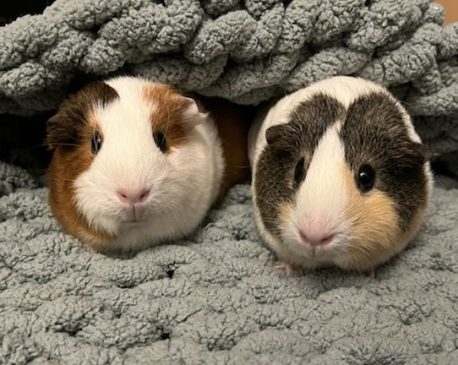
Remember that guinea pigs can hide illness very well, and symptoms may not have been readily apparent before the piggie’s passing. A vet check before adding new animals into the herd is the best choice.
Cage-mate Passing
Most guinea pigs will live for an average of 5-7 years, but some piggies leave us sooner due to genetics or illness. This is terribly sad for us human herd members, but the cage-mate(s) left behind will also grieve.
If the piggie that crossed the rainbow bridge was part of a group herd, it may not be necessary to add another pig to the mix. It is important to watch the herd closely in the following weeks as they redetermine the dominance hierarchy. If the passed pig was part of a pair, it is imperative to seek a new friend for your guinea pig ASAP. Solo pigs can quickly become depressed and stop eating, which is an emergency.
Before bringing in a new piggie, it is VERY important to determine the cause of death for the animal who passed. If it is possible the death was caused by an illness that was contagious, bringing a new pig into the home could be disastrous. We always recommend a vet visit for the remaining guinea pig before adoption.
It is also vital to quarantine any new pig coming into the home for at least a week to ensure they are healthy.
Finding the Right Personality
Every guinea pig has a unique personality, likes and dislikes. Unlike dogs or other animals, piggies have to “like” the other animal for a bond to be successful. Since guinea pigs have an intricate and well developed dominance hierarchy they need to all agree on who is 1st, 2nd and so on in that line. Disagreements on who is in charge can lead to fighting in both males and females.
The first step in a successful bond is to know your existing piggie’s personalities. Are they outgoing and vocal, shy, grumpy, clingy, chill or uptight? Do they become territorial over food, become nervous when handled or taking most things in stride? Have they ever lived with other pigs and did that go well? Once you have a handle on the particulars of your current pig’s personality you can begin to determine what type of partner might work.
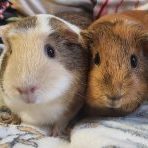

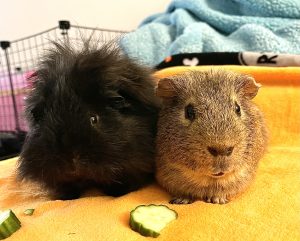
While a very young guinea pig might be easier to bond in the beginning, owners should consider that puberty can be a difficult transition for piggies and could result in a bond break. Bonding older pigs might take longer, but the bonds are more likely to stand the test of time.
Representatives may ask you questions about your current pigs or herd to select the best piggie to try and bond. This can make the task easier, but no bond is guaranteed to work. It is important to consider what you and your family will do if the bond goes sour and they cannot live together.
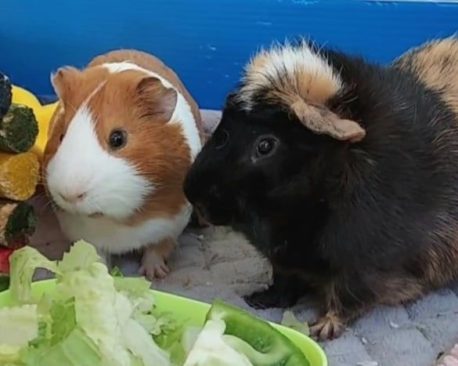
Setting up bonding properly from the beginning will give the best chance at success! Creating a neutral space takes some work but it is worth it!
Bonding in a Neutral Space
To prepare for the bonding, you will need to create a neutral space for the piggies to meet for the first time. This means there should be nothing in the space that smells like either pig. Fleeces, blankets or accessories place in the space should be new or thoroughly cleaned to remove scent.
The space should be large enough to provide “breathing room” if things get a bit tense but not so large the piggies can avoid each other completely. For a pair, we recommend a space equivalent to a large bathtub or a 2X4 cage. The space should be open and easily accessible if intervention is needed. No hides or houses should be provided at the start of the bonding. We suggest simply a large pig of hay in the center of the space, along with some veggies.
It is best to try and place the pigs in the bonding space at or near the same time to prevent anyone scenting anything to claim it. Once the pigs are in the bonding space, it is essential not to interfere or remove them unless the behavior risks causing injury. Normal bonding behavior can seem scary but some dominance displays are needed to develop the bond. Typically bonding can take between 2 and 4 hours.
Once the bonding is complete, move the pigs into a newly washed and flipped cage. Some dominance behaviors may resume for a short time when placed in the cage.
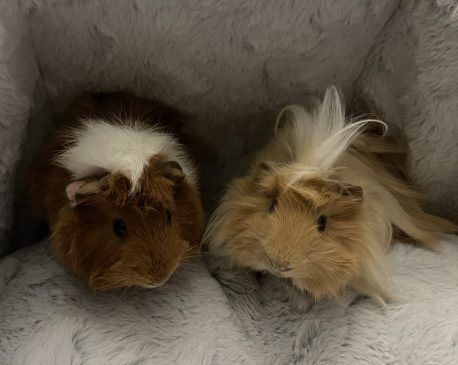
While males can have more intense dominance behaviors (even after bonding) due to the natural inclination to be in charge, male bonds can work just as well as female bonds.
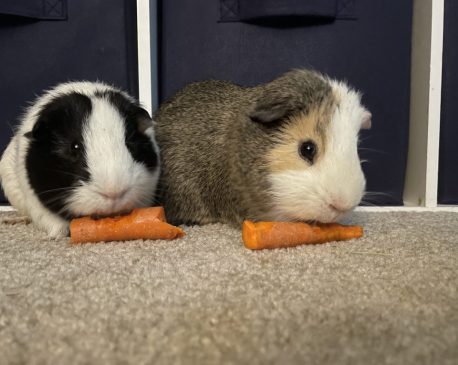
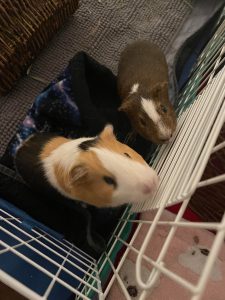
Bonding Best Practices
Here are some answers to the most common questions and concerns we see about bonding:
What types of behaviors are normal during bonding?
It is normal to see some chasing, mounting, teeth chattering and nose punching (even with female bonding). This can look very concerning, but it can be necessary when both piggies want to be in charge.
When should I intervene/remove pigs?
Sometimes a bonding will turn and need to be stopped. Prolonged chasing mixed with open-mouthed biting, ripping out tufts of fur, lunging with mouth open and violent circling called “ball of fur” are all signs the bonding will not work and needs to stop immediately.
Remember to have a towel handy to wrap around your hand before placing it in between fighting guinea pigs. Piggies might bite mistaking your hand for the other animal and bites can be painful and become infected.
What are some signs that the bonding is complete?
Once the piggies begin to eat side-by-side, groom themselves or each other or lay down/sleep the bond is near complete. At this point houses with two entrances and fresh veggies can be placed in the neutral space to see how the pigs will handle these additions.
If those additions work without increased hostility it is time to move the pigs into the clean and flipped cage.
Are boys really harder to bond than girls?
While males can have more intense dominance behaviors (even after bonding) due to the natural inclination to be in charge, male bonds can work just as well as female bonds. Males are often more close and affectionate to their cage-mates than females and will typically bond for life once dominance is settled.
The biggest thing to consider with male bonds is that they should never be kept in groups larger than two. Introducing other males into a pair can break the initial bond.
Can I bond a new big into a group of females?
Yes, it is possible to bond a new female into a larger herd (or a single neutered male into a female herd) but since more personalities are at play it can be more complicated. We recommend putting the entire herd into a very large space (kitchen or bathroom floor blocked for safety) and watch them very closely.
Here is a video with some bonding examples from LA Guinea Pig Rescue:
